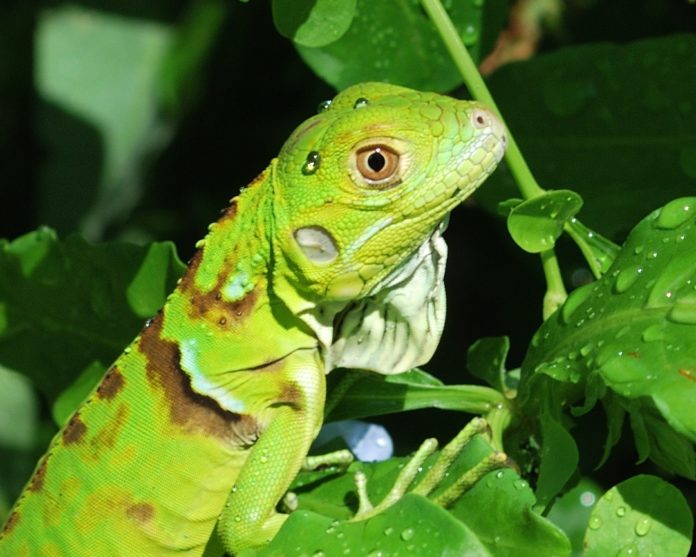
I grew up fascinated by all things that slithered, crept and crawled. As a boy, I kept cages stacked atop the two dressers in my bedroom where lizards and snakes lived and died.
By the time I was 15 or 16, I had stopped keeping them in cages and instead hunted them in the wild, where I took pictures to remember them. Suffice it to say, I was familiar with green iguanas long before I moved to Plantation Key.
Moving to the Florida Keys in 2001 was similar to moving back into my boyhood bedroom – in the sense that I was once again surrounded by slithering and crawling things.
There were fewer green iguanas on the islands 20 years ago – a great many, but not like they are now. They are everywhere in South Florida, the Keys and beyond, and there is nothing extraordinary about the report of green iguanas menacing (munching) their way across the yard. The common green iguana is a prevalent intruder at the Sioux Street office. They also leave behind poop that sometimes rains down from a tree limb overhead like a filthy, brief, torrential downpour.
Green iguanas are scientifically known by one of the all-time original Latin names, Iguana iguana. While Iguana iguana has all but taken over South Florida and the Keys, it is indigenous to Central and South America. How did they wind up in South Florida? It started with the exotic pet trade. The little green fellows escaped some of the enclosures attempting to hold them, and others were set free by thoughtless owners. In 1964, an exotic pet store owner from Miami released 300 green iguanas on purpose. Something became of that event because, as they keep reiterating in the “Jurassic Park” movie franchise, “Life finds a way.”
Iguanas are only one of the invasive species to arrive on the island chain and find the living to be good. One of the best things about being an invasive species is that the natives do not know what to do with you – plant or animal, they just slide in, start growing and take over. In the Florida Keys, the herbivorous iguanas (with a taste for bird eggs) with no natural predators are as common as cockroaches. In Key West, they have been seen feeding on scraps of food discarded from restaurant tables, sometimes lettuce, on occasion French fries, like common chickens.
Back at Sioux Street, a plethora of invasive species have staked out the yard. While cats rid the local neighborhoods of a spattering of iguanas, most dead ones show up splattered in green and red on the road.
In addition to Iguana iguana, there are brown anoles. When we moved on to the property eight or nine years ago, many more brown anoles lived here.
Because brown anoles arrived so long ago, in the late 19th century, they are not always lumped into the invasive category. They are. Brown anoles competed for resources and habitat with the native Carolina anole. To compete with the invaders, the green anoles, sometimes called the American chameleon, moved higher up into trees.
These days, there are not so many brown anoles in the yard – not since the curly-tailed lizards moved in.
Six or seven years ago, they had yet to set their scaly little fingers on the property, and brown anoles skittered away with every step it took to walk out to the street and check the mailbox. Now, the curly tails run when they see me approaching. I have strong feelings about curly-tailed lizards, and ones I do not share with Iguana iguana (much to my wife’s chagrin). Curly-tailed lizards are bigger and faster than their anole counterparts and not only out-compete them for resources but eat them – especially when the summer babies hatch.
Curly-tailed lizards are also a cocky species and the primary reason the defiant lizards are not infrequently seen flattened by automobile tires on the road. They can also be compared to the invasive lionfish when wreaking havoc on an ecosystem. Lionfish are voracious feeders with no natural predators in their unnatural environment, which is one of the reasons it has been so easy for them to dominate the reef.
Back on land, curly-tailed lizards may begin encountering a new threat. No longer simply hunters, they may start to be the hunted, too. An African species called a red-headed agama, a bigger, stronger and faster lizard, is making inroads on the island chain. It will be interesting to see if, a decade or two down the road, the agamas have affected curly-tailed lizard populations, if brown anoles have been relegated to niche populations, and if the native Carolina anoles ever come down from the safety of their trees.

























